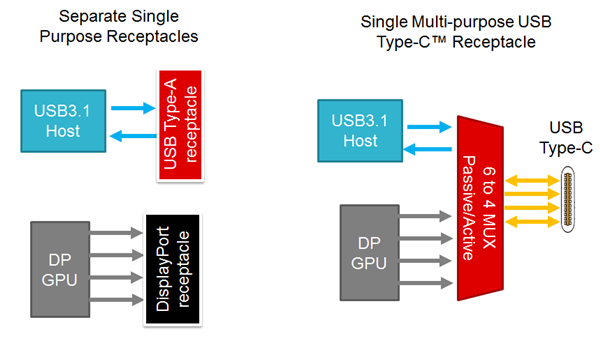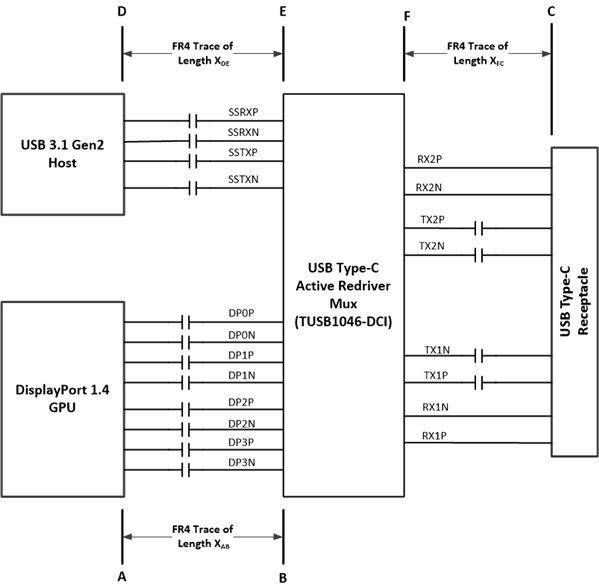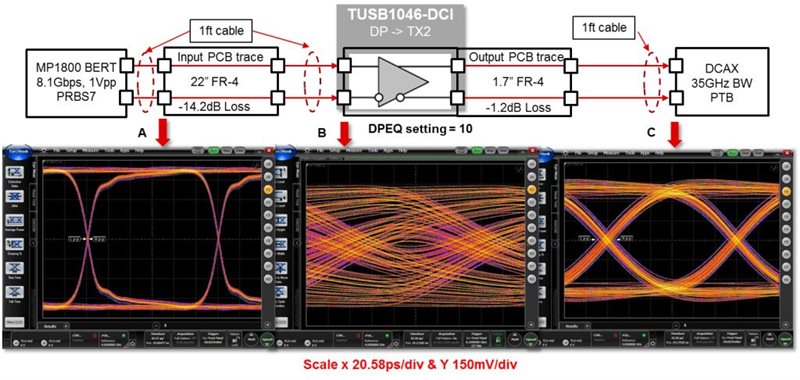-
How to Correct 10Gbps Performance Issues with a USB Type-C™ Active Redriver Multiplexer SSZTAK3 december 2016 TPS65982 , TUSB1002 , TUSB1042I , TUSB1046-DCI , TUSB1046A-DCI , TUSB501 , TUSB522P , TUSB542 , TUSB544 , TUSB546-DCI , TUSB546A-DCI , TUSB551 , TUSB564
-
How to Correct 10Gbps Performance Issues with a USB Type-C™ Active Redriver Multiplexer
How to Correct 10Gbps Performance Issues with a USB Type-C™ Active Redriver Multiplexer
Michael Campbell
With today’s 4K ultra high-definition (UHD) TVs (and future 8K UHD TVs), as well as solid-state storage speeds, more video and data bandwidth is a must. Interface standards groups in the industry are addressing this trend by enabling more video and data bandwidth. For example, the Video Electronics Standards Association (VESA) DisplayPort 1.4 standard enables 4K and 8K video via four 8.1Gbps (known as high bit rate 3 (HBR3) lanes. The USB Implementers Forum (IF) introduced the USB 3.1 standard to boost data bandwidth from 5Gbps (SuperSpeed or Gen 1) to 10Gbps (SuperSpeed Plus or Gen 2). The USB IF also introduced the USB Type-C standard to bring data and video into a single small receptacle. This USB Type-C connector benefits system developers by enabling the removal of multiple single-purpose receptacles like DisplayPort and USB Type-A and replacing them with USB Type-C, enabling small-form-factor designs (Figure 1). These benefits create their own challenges for system developers.
 Figure 1 Migration to a Single
Multi-purpose USB Type-C Receptacle
Figure 1 Migration to a Single
Multi-purpose USB Type-C ReceptacleGraphics processing units (GPUs) and USB 3.1 host controllers are not typically located in the same physical place in the system as depicted in Figure 2. Add to this the need for multiple USB Type-C ports in a product (for example, notebooks may have Type-C ports on the back as well as on the sides), the distance that USB 3.1 and DisplayPort high-speed signals must traverse can become very long. Thus, a USB Type-C active redriver multiplexer (like the TUSB1046-DCI) that can compensate for frequency-dependent loss introduced over long channels is a must for a Type-C system.
 Figure 2 TUSB1046-DCI in a USB Type-C
System
Figure 2 TUSB1046-DCI in a USB Type-C
SystemA frequency-dependent lossy medium, like an FR4 printed circuit board (PCB) trace, will cause attenuated signals and produce a closed eye. This frequency-dependent loss causes inter-symbol interference (ISI).
Figure 3 depicts the impact a 22-inch FR4 PCB trace has on an 8.1Gbps pseudorandom binary sequence (PRBS) 7 signal. Before the 22 inches of trace (point A), the eye produced by the bit-error-rate tester (BERT) signal source is open, with little to no jitter. After the 22 inches of trace (point B), the eye is closed entering the TUSB1046-DCI DisplayPort input. The TUSB1046-DCI does its job of correcting the closed eye at the input by outputting a low-jitter open eye (point C) with enough eye-width and eye-height margins to pass DisplayPort 1.4 standard compliance. For optimum performance, choose a specific high-frequency boost (equalization setting) to match the PCB trace loss. In this particular example, an equalization (EQ) setting of 10 was used to match the 14.2dB loss of the PCB trace at 4.05GHz.
 Figure 3 The TUSB1046-DCI’s Impact on
DisplayPort Performance
Figure 3 The TUSB1046-DCI’s Impact on
DisplayPort PerformanceIf you replace the BERT in Figure 2 with a GPU and routed the GPU’s signal through a Type-C passive multiplexer to the Type-C receptacle, the signal at the receptacle would be completely closed and not compliant to the DisplayPort 1.4 standard. A UHD TV connected to such a USB Type-C port would likely not work. But with the TUSB1046-DCI’s ability to compensate for ISI, you can obtain a DisplayPort 1.4-compliant signal at the USB Type-C receptacle.
An active redriver multiplexer can compensate for both DisplayPort and USB 3.1 ISI-related losses and is an excellent solution for systems in which FR4 PCB-related losses require a redriver to produce USB 3.1 Gen 2- and DisplayPort 1.4-compliant signals at the Type-C receptacle. Make your signals compliant quickly, using the TUSB1046 USB Type-C Alternate Mode Redriver Switch Evaluation Module (EVM).
Additional Resources
- The TUSB546-DCI is available for 5Gbps systems requiring a USB3.1 Gen 1 and DisplayPort 1.4 USB Type-C active redriver multiplexer.
- Read the white paper, “USB 3.1 Channel Loss Budgets.”
- Download the data sheets:
- 10Gbps Type-C redriver multiplexer TUSB1046 data sheet.
- 5Gbps Type-C redriver multiplexer TUSB546 data sheet.
- Read more about the TPS65982 USB Type-C and USB Power Delivery controller, power switch and multiplexer.
IMPORTANT NOTICE AND DISCLAIMER
TI PROVIDES TECHNICAL AND RELIABILITY DATA (INCLUDING DATASHEETS), DESIGN RESOURCES (INCLUDING REFERENCE DESIGNS), APPLICATION OR OTHER DESIGN ADVICE, WEB TOOLS, SAFETY INFORMATION, AND OTHER RESOURCES “AS IS” AND WITH ALL FAULTS, AND DISCLAIMS ALL WARRANTIES, EXPRESS AND IMPLIED, INCLUDING WITHOUT LIMITATION ANY IMPLIED WARRANTIES OF MERCHANTABILITY, FITNESS FOR A PARTICULAR PURPOSE OR NON-INFRINGEMENT OF THIRD PARTY INTELLECTUAL PROPERTY RIGHTS.
These resources are intended for skilled developers designing with TI products. You are solely responsible for (1) selecting the appropriate TI products for your application, (2) designing, validating and testing your application, and (3) ensuring your application meets applicable standards, and any other safety, security, or other requirements. These resources are subject to change without notice. TI grants you permission to use these resources only for development of an application that uses the TI products described in the resource. Other reproduction and display of these resources is prohibited. No license is granted to any other TI intellectual property right or to any third party intellectual property right. TI disclaims responsibility for, and you will fully indemnify TI and its representatives against, any claims, damages, costs, losses, and liabilities arising out of your use of these resources.
TI’s products are provided subject to TI’s Terms of Sale (www.ti.com/legal/termsofsale.html) or other applicable terms available either on ti.com or provided in conjunction with such TI products. TI’s provision of these resources does not expand or otherwise alter TI’s applicable warranties or warranty disclaimers for TI products.
Mailing Address: Texas Instruments, Post Office Box 655303, Dallas, Texas 75265
Copyright © 2023, Texas Instruments Incorporated